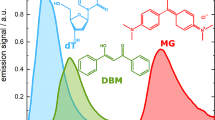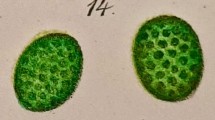Abstract
Persistent non-photochemical hole burning at 4.2 K is an efficient experimental tool to unravel position and nature of low-energy excitonic states in pigment-protein complexes. This is demonstrated here for the case of the trimeric chlorophyll (Chl) a/b light-harvesting complexes of Photosystem II (LHC II) of green plants, where previous work (Pieper et al. J Phys Chem B 103:2412, 1999a) reported a highly localized lowest energy state at 680 nm. At that time, this finding appeared to be consistent with the contemporary knowledge about the LHC II structure, which mainly suggested the presence of weakly coupled Chl heterodimers. Currently, however, it is widely accepted that the lowest state is associated with an excitonically coupled trimer of Chl molecules at physiological temperatures. This raises the question, why an excitonically coupled state has not been identified by spectral hole burning. A re-inspection of the hole burning data reveals a remarkable dependence of satellite hole structure on burn fluence, which is indicative of the excitonic coupling of the low-energy states of trimeric LHC II. At low fluence, the satellite hole structure of the lowest/fluorescing ~ 680 nm state is weak with only one shallow satellite hole at 649 nm in the Chl b spectral range. These findings suggest that the lowest energy state at ~ 680 nm is essentially localized on a Chl a molecule, which may belong to a Chl a/b heterodimer. At high fluence, however, the lowest energy hole shifts blue to ~ 677 nm and is accompanied by two satellite holes at ~ 673 and 663 nm, respectively, indicating that this state is excitonically coupled to other Chl a molecules. In conclusion, LHC II seems to possess two different, but very closely spaced lowest energy states at cryogenic temperatures of 4.2 K.


taken from Pieper et al. (1999a) with permission, copyright 1999 American Chemical Society


Similar content being viewed by others
Abbreviations
- Car:
-
Carotenoid
- Chl:
-
Chlorophyll
- EET:
-
Excitation energy transfer
- FLN:
-
Fluorescence line-narrowing
- LHC II:
-
Light-harvesting complex II
- SHB:
-
Spectral hole burning
References
Akhtar P, Do TN, Nowakowski PJ, Huerta-Viga A, Khyasudeen MF, Lambrev PH, Tan HS (2019) Temperature dependence of the energy transfer in lhcii studied by two-dimensional electronic spectroscopy. J Phys Chem B 123:6765–6775
Croce R, Müller MG, Bassi R, Holzwarth AR (2001) Carotenoid-to-chlorophyll energy transfer in recombinant major light-harvesting complex (LHC II) of higher plants. I. Femtosecond Trans Absorpt Measurements Biophys J 80:901–915
Demmig-Adams B, Adams WW, Garab G, Govindjee U (2014) Non-photochemical quenching and energy dissipation in plants, algae and cyanobacteria preface. Adv Photosynth Resp 40:27–30
Do TN, Huerta-Viga A, Akhtar P, Nguyen HL, Nowakowski PJ, Khyasudeen MF, Lambrev PH, Tan HS (2019) Revealing the excitation energy transfer network of Light-Harvesting Complex II by a phenomenological analysis of two-dimensional electronic spectra at 77 K. J Chem Phys 151:205101
Gibasiewicz K, Rutkowski M, van Grondelle R (2009) Fluorescence hole-burning and site-selective studies of LHCII. Photosynthetica 47:232–240
Golub M, Rusevich L, Irrgang KD, Pieper J (2018) Rigid versus flexible protein matrix: light-harvesting complex II exhibits a temperature-dependent phonon spectral density. J Phys Chem B 122:7111–7121
Gradinaru CC, van Stokkum IHM, Pascal AA, van Grondelle R, van Amerongen H (2000) Identifying the pathways of energy transfer between carotenoids and chlorophylls in LHCII and CP29. a multicolor, femtosecond pump-probe study. J Phys Chem B 104:9330–9342
Gryliuk G, Rätsep M, Hildebrandt S, Irrgang KD, Eckert HJ, Pieper J (2014) Excitation energy transfer and electron-vibrational coupling in phycobiliproteins of the cyanobacterium Acaryochloris marina investigated by site-selective spectroscopy. BBA 1837:1490–1499
Irrgang KD, Boekema EJ, Vater J, Renger G (1988) Structural determination of the Photosystem II core complex from spinach. Eur J Biochem 178:209–217
Jankowiak R, Reppert M, Zazubovich V, Pieper J, Reinot T (2011) Site selective and single complex laser-based spectroscopies: a window on excited state electronic structure, excitation energy transfer, and electron-phonon coupling of selected photosynthetic complexes. Chem Rev 111:4546–4598
Krikunova M, Voigt B, Lokstein H (2002) Direct evidence for excitonically coupled chlorophylls a and b in LHC II of higher plants by nonlinear polarization spectroscopy in the frequency domain. BBA 1556:1–5
Kühlbrandt W, Wang DN, Fujiyoshi Y (1994) Atomic model of plant light-harvesting complex by electron crystallography. Nature 367:614–621
Lewis NH, Gruenke NL, Oliver TA, Fleming GR, Ballottari M, Bassi R (2016) Observation of electronic excitation transfer through light harvesting complex II using two-dimensional electronic-vibrational spectroscopy. J Phys Chem Lett 7:4197–4206
Liu Z, Yan H, Wang K, Kuang T, Zhang J, Gui L, An X, Chang W (2004) Crystal structure of spinach major light-harvesting complex at 2.72 Å resolution. Nature 428:287–292
Martiskainen J, Kananavicius R, Linnanto J, Lehtivuori H, Keranen M, Aumanen V, Tkachenko N, Korppi-Tommola J (2011) Excitation energy transfer in the lhcii trimer: from carotenoids to chlorophylls in space and time. Photosynth Res 107:195–207
Mirkovic T, Ostroumov EE, Anna JM, van Grondelle R, Govindjee SGD (2017) Light absorption and energy transfer in the antenna complexes of photosynthetic organisms. Chem Rev 117:249–293
Müh F, Madjet A, Renger T (2010) structure-based identification of energy sinks in plant light-harvesting complex II. J Phys Chem B 114:13517–13535
Novoderezhkin VI, Palacios MA, van Amerongen H, van Grondelle R (2005) Excitation dynamics in the LHC II complex of higher plants: modeling based on the 2.72 angstrom crystal structure. J Phys Chem B 109:10493–10504
Pieper J, Rätsep M, Jankowiak R, Irrgang KD, Voigt J, Renger G, Small GJ (1999a) Q(y)-level structure and dynamics of solubilized Light-Harvesting Complex II of green plants: pressure and hole burning studies. J Phys Chem A 103:2412–2421
Pieper J, Irrgang KD, Rätsep M, Jankowiak R, Schrötter T, Voigt J, Small GJ, Renger G (1999b) Effects of aggregation on trimeric light-harvesting complex II of green plants: a hole-burning study. J Phys Chem A 103:2422–2428
Pieper J, Schödel R, Irrgang KD, Voigt J, Renger G (2001) Electron-phonon coupling in solubilized LHC II complexes of green plants investigated by line-narrowing and temperature-dependent fluorescence spectroscopy. J Phys Chem B 105:7115–7124
Pieper J, Irrgang KD, Renger G, Lechner RE (2004) Density of vibrational states of the light-harvesting complex II of green plants studied by inelastic neutron scattering. J Phys Chem B 108:10556–10565
Pieper J, Rätsep M, Irrgang KD, Freiberg A (2009) Chromophore-chromophore and chromophore-protein interactions in monomeric light-harvesting complex II of green plants studied by spectral hole burning and fluorescence line narrowing. J Phys Chem B 113:10870–10880
Pieper J, Rätsep M, Trostmann I, Schmitt FJ, Theiss C, Paulsen H, Renger G, Freiberg A (2011) Excitonic energy level structure and pigment-protein interactions in the recombinant water-soluble chlorophyll protein. II. Spectral hole-burning experiments. J Phys Chem B 115:4053–4065
Pieper J, Rätsep M, Golub M, Schmitt FJ, Artene P, Eckert HJ (2017) Excitation energy transfer in phycobiliproteins of the cyanobacterium Acaryochloris marina investigated by spectral hole burning. Photosyn Res 133:225–234
Ramanan C, Ferretti M, van Roon H, Novoderezhkin VI, van Grondelle R (2017) Evidence for coherent mixing of excited and charge-transfer states in the major plant light-harvesting antenna LHCII. Phys Chem Chem Phys 19:22877
Reddy NRS, van Amerongen H, Kwa SLS, van Grondelle R, Small GJ (1994) Low-energy exciton level structure and dynamics in Light Harvesting Complex II trimers from the Chl a/b complex of Photosystem II. J Phys Chem 98:4729–4735
Remelli R, Varotto C, Sandona D, Croce R, Bassi R (1999) Chlorophyll binding to monomeric light-harvesting complex: a mutational analysis of chromophore-binding residues. J Biol Chem 274:33510–33521
Rogl H, Schödel R, Lokstein H, Kühlbrandt W, Schubert A (2002) Assignment of spectral substructures to pigment-binding sites in higher plant light-harvesting complex LHC-II. Biochemistry 41:2281–2287
Standfuss J, Kühlbrandt W (2004) The three isoforms of the light-harvesting complex II: spectroscopic features, trimer formation, and functional roles. J Biol Chem 279:36884–36891
Standfuss J, Terwisscha van Scheltinga AC, Lamborghini M, Kühlbrandt W (2005) Mechanisms of photoprotection and nonphotochemical quenching in pea light-harvesting complex at 2.5 Å resolution. EMBO J 24:919–928
van Amerongen H, van Grondelle R (2001) Understanding the energy transfer function of LHCII, the major light-harvesting complex of green plants. J Phys Chem B 105(3):604–617
van Grondelle R, Novoderezhkin VI (2006) Energy transfer in photosynthesis: experimental insights and quantitative models. Phys Chem Chem Phys 8(7):793–807
Voigt J, Renger T, Schödel R, Schrötter T, Pieper J, Redlin H (1996) Excitonic effects in the light-harvesting chl a/b-protein complex of higher plants. PSS B 194:333–350
Voigt B, Irrgang KD, Ehlert J, Beenken W, Renger G, Leupold D, Lokstein H (2002) Spectral substructure and excitonic interactions in the minor photosystem II antenna complex CP29 as revealed by non-linear polarization spectroscopy in the frequency domain. Biochemistry 41:3049–3056
Vrandecic K, Rätsep M, Wilk L, Rusevich L, Golub M, Reppert M, Irrgang KD, Kühlbrandt W, Pieper J (2015) Protein dynamics tunes excited state positions in light-harvesting complex II. J Phys Chem B 119:3920–3930
Zucchelli G, Santabarbara S, Jennings RC (2012) The Q(Y) absorption spectrum of the light-harvesting complex II as determined by structure-based analysis of chlorophyll macrocycle deformations. Biochemistry 51:2717–2736
Acknowledgements
Financial support by the Estonian Research Council (Grants PRG 539 and SLOKT 12026 T) is gratefully acknowledged. K.-D. I. is thankful for support from Deutsche Forschungsgemeinschaft (SFB 429, TP A1 and TP A3, respectively). We are also grateful to S. Kussin and M. Weß (TU Berlin) for their help in sample preparation.
Author information
Authors and Affiliations
Corresponding author
Ethics declarations
Conflict of interest
The authors declare that they have no conflict of interest.
Additional information
Publisher's Note
Springer Nature remains neutral with regard to jurisdictional claims in published maps and institutional affiliations.
Rights and permissions
About this article
Cite this article
Pieper, J., Irrgang, KD. Nature of low-energy exciton levels in light-harvesting complex II of green plants as revealed by satellite hole structure. Photosynth Res 146, 279–285 (2020). https://doi.org/10.1007/s11120-020-00752-9
Received:
Accepted:
Published:
Issue Date:
DOI: https://doi.org/10.1007/s11120-020-00752-9




